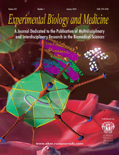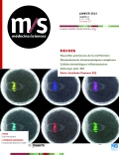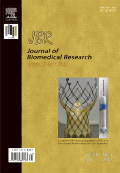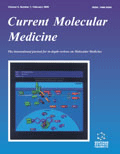
EXPERIMENTAL BIOLOGY AND MEDICINE
Scope & Guideline
Fostering collaboration through cutting-edge research.
Introduction
Aims and Scopes
- Translational Research:
The journal emphasizes translational research that translates basic scientific discoveries into clinical applications, addressing health challenges and improving patient outcomes. - Innovative Therapeutic Approaches:
Research on novel therapeutic strategies, including drug development, gene therapy, and regenerative medicine, is a core focus, highlighting innovative methods to treat various diseases. - Mechanistic Studies:
Studies elucidating the underlying biological mechanisms of diseases, particularly at the molecular and cellular levels, are prominently featured to enhance understanding of pathophysiology. - Systems Biology and Bioinformatics:
The integration of systems biology and bioinformatics approaches is encouraged to analyze complex biological data, identify biomarkers, and predict therapeutic responses. - Interdisciplinary Approaches:
The journal promotes interdisciplinary research that combines insights from biology, medicine, engineering, and computational sciences to tackle complex health issues. - Clinical and Experimental Studies:
A balance of clinical and experimental studies is maintained, with a focus on the application of experimental findings to clinical settings.
Trending and Emerging
- Precision Medicine:
There is a significant increase in research focused on precision medicine, which tailors treatment strategies based on individual genetic, environmental, and lifestyle factors, enhancing therapeutic efficacy. - Neuroinflammation and Neurological Disorders:
Recent studies increasingly address the role of neuroinflammation in various neurological disorders, highlighting the importance of understanding immune responses in the central nervous system. - Microbiome Research:
Research exploring the role of the microbiome in health and disease is gaining traction, with studies investigating how gut flora influences metabolic processes, immune function, and disease susceptibility. - Regenerative Medicine and Stem Cell Therapy:
There is a rising interest in regenerative medicine, particularly the application of stem cell therapies for tissue repair and the treatment of degenerative diseases. - Artificial Intelligence in Healthcare:
The integration of artificial intelligence and machine learning techniques in biomedical research is emerging as a critical area, with applications ranging from drug discovery to personalized treatment plans. - Immunotherapy and Cancer Research:
Immunotherapy continues to be a major focus, with increasing research into novel immune-based therapies for cancer treatment and the mechanisms underlying immune evasion by tumors.
Declining or Waning
- Traditional Pharmacology:
Research focused solely on traditional pharmacological approaches is less popular, as the field increasingly shifts towards personalized medicine and targeted therapies. - Basic Animal Models:
While animal studies remain important, there is a noticeable decline in publications using basic animal models without translational relevance, as researchers seek more sophisticated models that better mimic human diseases. - Single-Factor Studies:
The trend towards studies examining single factors or variables in isolation is waning, with a growing preference for multi-factorial studies that consider complex interactions. - In vitro Studies without Clinical Relevance:
In vitro studies that do not connect to clinical implications or therapeutic applications are being published less frequently, as the journal emphasizes studies with direct relevance to human health. - Epidemiological Studies without Molecular Insights:
Epidemiological studies that lack molecular or mechanistic insights into the diseases studied are becoming less prominent, reflecting a preference for research that integrates population data with biological understanding.
Similar Journals

M S-MEDECINE SCIENCES
Bridging theory and practice in life sciences.M S-MEDECINE SCIENCES, published by EDP SCIENCES S A, is an esteemed journal based in France dedicated to the fields of biochemistry, genetics, and medicine. With an ISSN of 0767-0974 and an E-ISSN of 1958-5381, this journal has been a platform for scholarly communication since its inception in 1990 and continues to present critical advancements in these scientific domains, aiming to bridge theoretical research with practical applications. Despite its current Q4 ranking in both Biochemistry, Genetics and Molecular Biology and Medicine categories, the journal aspires to enhance its visibility and impact within the academic community. Researchers and professionals can benefit from a wealth of studies that contribute to the understanding of complex biological systems and medical innovations. Interested authors are encouraged to explore the journal's submission guidelines and contribute to the growing body of knowledge in these important fields.

BioScience Trends
Exploring the Intersection of Science and HealthBioScience Trends, published by IRCA-BSSA, is a leading academic journal based in Japan that significantly contributes to the fields of biochemistry, genetics, molecular biology, and social health sciences. With an impactful Scopus ranking that places it in the 97th percentile for health social sciences and the 89th percentile for general biochemistry, this journal is an essential resource for researchers and professionals alike. Since its inception in 2007, BioScience Trends has fostered high-quality research dissemination and collaboration, offering a platform for innovative studies and insights that are vital for advancing knowledge in life sciences. Despite being a non-open access publication, it maintains rigorous standards and a reputable presence in the academic community, with an impressive categorization into Q1 and Q2 quartiles as of 2023. Researchers, students, and professionals seeking to stay at the forefront of scientific exploration and health advancements will find BioScience Trends to be an invaluable source for scholarly articles and emerging trends in their respective fields.

Journal of Biomedical Research
Fostering Interdisciplinary Research for Improved Health OutcomesJournal of Biomedical Research, published by Nanjing Medical University in China, is a prominent platform for groundbreaking discoveries in the fields of Biochemistry, Genetics, and Molecular Biology, as well as Medicine. With an ISSN of 1674-8301 and an E-ISSN of 1876-4819, the journal offers a vital opportunity for researchers, professionals, and students to disseminate insightful research findings. Although not currently available as an open access journal, its inclusion in the second quartile of both Biochemistry and Medicine categories underscores its growing influence and commitment to high-quality scholarship, as evidenced by its historical compliance with Scopus rankings prior to 2009. By fostering an interdisciplinary approach, the Journal of Biomedical Research aims to bridge gaps in current biomedical understanding and encourages innovative research that can lead to significant contributions in improving health outcomes. Its editorial policies guarantee rigorous peer review, making it a trusted source of knowledge in the biomedical community.

CURRENT MOLECULAR MEDICINE
Unveiling Innovations in Biochemistry and GeneticsCURRENT MOLECULAR MEDICINE is a pivotal journal fostering advancements in the interdisciplinary fields of molecular medicine, biochemistry, and genetics. Published by Bentham Science Publishers, this esteemed journal has been disseminating vital research findings since its inception in 2001 and is continuously dedicated to exploring the molecular basis of health and disease. With a focus on translational research, CURRENT MOLECULAR MEDICINE provides an invaluable platform for researchers, healthcare professionals, and students, making significant contributions to the understanding of molecular mechanisms and therapeutic strategies. With an ISSN of 1566-5240 and an E-ISSN of 1875-5666, the journal holds a commendable position within the scientific community, being ranked Q3 in Biochemistry and Molecular Biology and Q2 in Medicine (miscellaneous) as of 2023. This journal does not currently operate on an open access model but remains accessible through various institutional subscriptions. The multidisciplinary scope covering molecular biology to medicinal applications positions CURRENT MOLECULAR MEDICINE as an essential resource for those striving to meet the challenges of modern healthcare and biomedical research.

EXPERIMENTAL AND MOLECULAR MEDICINE
Advancing the frontiers of molecular medicine.EXPERIMENTAL AND MOLECULAR MEDICINE, published by SpringerNature, is a premier open-access journal that has been at the forefront of biomedical research since its establishment in 1996. With a focus on innovative studies in biochemistry, molecular biology, and clinical biochemistry, the journal has consistently maintained a distinguished position within the top quartile (Q1) across multiple categories, underscoring its significant impact in these fields. The journal offers researchers and practitioners a platform for high-quality, peer-reviewed articles that advance our understanding of molecular mechanisms underlying health and disease. As a crucial resource for scholars seeking to explore cutting-edge research and practical advancements, its inclusion in relevant databases such as Scopus reflects an exceptional ranking with notable percentiles—placing it among the best in biomedical sciences. With a commitment to open access, EXPERIMENTAL AND MOLECULAR MEDICINE ensures that findings are readily available to the global academic community, facilitating collaboration and innovation in molecular medicine.

Advances in Clinical and Experimental Medicine
Unlocking Innovations for Healthcare AdvancementWelcome to Advances in Clinical and Experimental Medicine, an esteemed publication by WROCLAW MEDICAL UNIVERSITY, dedicated to advancing the essential fields of clinical and experimental medicine. With an open access model since 2017, this journal ensures that researchers, healthcare professionals, and students worldwide can freely access high-quality scientific content. Covering a broad spectrum of topics including biochemistry, genetics, internal medicine, and pharmacology, Advances in Clinical and Experimental Medicine has established itself as a pivotal resource in the scientific community, currently holding prestigious rankings such as Q2 in Biochemistry, Genetics, and Molecular Biology (miscellaneous) and Q1 in Reviews and References (medical) for 2023. Spanning over two decades of rigorous research publication, the journal is a critical platform for sharing innovative findings and fostering collaboration among scholars, making it an invaluable asset for those at the forefront of medical science.

BULLETIN OF EXPERIMENTAL BIOLOGY AND MEDICINE
Advancing the Frontiers of Biological and Medical ResearchBULLETIN OF EXPERIMENTAL BIOLOGY AND MEDICINE is a prestigious journal published by SPRINGER, dedicated to advancing knowledge in the fields of biochemistry, genetics, molecular biology, and medicine. Established in 1956 and continuing to be relevant through to 2024, this journal provides a vital platform for researchers to publish original findings and significant reviews that contribute to these essential disciplines. With an ISSN of 0007-4888 and an E-ISSN of 1573-8221, it enjoys a respectable standing in the academic community, currently positioned in the Q3 quartile of both Biochemistry, Genetics and Molecular Biology, and Medicine categories for 2023. Despite its traditional subscription model, the journal reaches a wide audience of professionals, students, and researchers, who benefit from timely access to impactful research and experimental studies. By fostering a rich dialogue in experimental biology and medicine, this journal plays an important role in shaping ongoing research and understanding of complex biological systems.

World of Medicine and Biology
Bridging theory and practice in the life sciences.World of Medicine and Biology is a leading academic journal dedicated to advancing the frontiers of medical and biological sciences. Published by the Scientific Society of Anatomists, Histologists & Embryologists in Ukraine, this journal provides a collaborative platform for researchers, professionals, and students to disseminate original research, critical reviews, and insightful discussions on a wide array of topics in these dynamic fields. With the ISSN 2079-8334, the journal aspires to bridge the gap between theory and practice, focusing on innovative methodologies, latest findings, and the relevance of biology to human health. Although the journal operates under a traditional access model, it ensures comprehensive reach through various indexing services and databases, solidifying its importance in the realm of scientific inquiry. As the field continues to evolve with new discoveries and technologies, the World of Medicine and Biology remains committed to fostering academic excellence and supporting the global research community in their endeavors.

Cell Reports Medicine
Pioneering the future of healthcare with cutting-edge insights.Cell Reports Medicine, published by Cell Press, represents a pivotal advancement in the open access landscape of biomedical research since its inception in 2020. With a dedicated focus on the intersection of medicine, biochemistry, genetics, and molecular biology, this journal has quickly established itself as a key resource, earning a remarkable Q1 ranking in these fields. Based in the United States, Cell Reports Medicine boasts impressive metrics, ranking #25 out of 636 in General Medicine and #18 out of 221 in Biochemistry, underscoring its influence and reach within the scientific community, with a notable 96th and 92nd percentile respectively. As a fully open access journal, it fosters global dissemination of knowledge, ensuring that groundbreaking research is readily available to researchers, professionals, and students alike. The journal not only promotes high-quality research but also aims to bridge the gap between molecular discoveries and clinical applications, making it an essential addition to any academic library or researcher's toolkit.

INDIAN JOURNAL OF EXPERIMENTAL BIOLOGY
Unveiling the Mysteries of Molecular BiologyINDIAN JOURNAL OF EXPERIMENTAL BIOLOGY, published by the NATL INST SCIENCE COMMUNICATION-NISCAIR, stands as a significant platform for the dissemination of original research in the fields of biochemistry, genetics, and molecular biology, particularly within the context of Indian scientific advancements. With its ISSN 0019-5189 and E-ISSN 0975-1009, the journal has been an essential resource since its inception in 1965, although coverage in prominent databases like Scopus was discontinued in 2018. The journal ranks in the 57th percentile for Biotechnology, as well as in the 27th and 25th percentiles for Molecular Biology and Cell Biology respectively, underscoring its impact and relevance. While currently not an Open Access journal, it continues to provide valuable insights and contributions from researchers and professionals in the growing field of experimental biology. The esteemed contributions published in this journal enhance our understanding of biological processes and foster the development of innovative solutions to contemporary challenges in health and environmental science.